|
Entrance to the old workhouse was in Hockerill Street between two associated buildings: one a large dwelling house, the other a smaller property used or owned by the Trustees of the Charities of Bishop's Stortford. This body was responsible for many duties about the town, including the running of the workhouse. But it was probably the master of the workhouse in conjunction with the overseers' who decided who should be admitted. Inmates were mostly pauper men and women but the workhouse also housed orphans, illegitimate children, vagrants, the sick and infirm who were temporarily out of work and unable to manage on outdoor relief, as well as able-bodied labourers who were unemployed due to their seasonal occupations.
It is impossible to speculate on the size of the workhouse when first built. However, additional land purchases in the early 19th century led to a complex that stretched beyond an acre in extent by the time the workhouse closed in 1837. Surrounded by high brick and stone walls, it then comprised of four exercise and recreation yards – one for women, one for boys, two for men – and a variety of brick and timber-built buildings necessary for the day-to-day running of the workhouse. These included a millhouse, storeroom, bakehouse, washhouse, brewhouse, kitchen, workshops, piggery, and privvies. The largest building, probably two-storeys high, housed male and female sleeping wards and an infirmary. An adjacent dining hall doubled as a chapel. Tramps were probably housed in a separate barn, as Vestry minutes dated 21 March 1831 record: 'barn of Mr Gee be used for lodgings of trampers and each receive half pound of bread'.
Despite the fact that Bishop’s Stortford’s workhouse was created to help relieve human misery, the Vestry ran it as a ruthless business - continually looking for ways to cut expenditure in order to reduce the parish poor rate. These measures included cutting the cost of feeding the inmates, even though most vegetables for paupers' consumption were grown in the workhouse garden while the bakehouse produced the staple diet of bread. In 1830 inmates cost 5s 6d (27p) per head per week, nearly 1s (5p) more than in St Luke's, Chelsea, and almost 2s (10p) more per head than the parish of Woodbridge in Suffolk. The Vestry concluded that most of this undue expense was due to poor management by the master of the workhouse, Mr Anthony, and that a considerable saving could be made if it were run by a man with no family of his own. Not surprisingly Mr Anthony resigned his post soon after, giving three months notice.
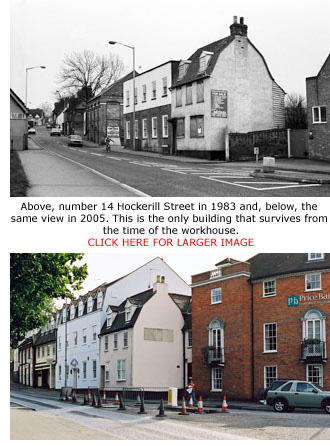 But in May 1830 the Vestry voiced further concern about expenditure. It was now felt that 'an unnecessary and wasteful consumption of food had lately been allowed to the paupers, and that a considerably less quantity could be used without diminishing their comfort.' They added that weekly allowances didn't take paupers' good conduct into account - suggesting, perhaps, that misdeeds by individuals should be punished by a 'stricter' diet. But in May 1830 the Vestry voiced further concern about expenditure. It was now felt that 'an unnecessary and wasteful consumption of food had lately been allowed to the paupers, and that a considerably less quantity could be used without diminishing their comfort.' They added that weekly allowances didn't take paupers' good conduct into account - suggesting, perhaps, that misdeeds by individuals should be punished by a 'stricter' diet.
The poor rate was further subsidised by profits made from on-site workshops staffed by inmates. One such manufactory – producing sacks, rope and twine – was seemingly owned by a Mr Sergant [sic], who lived in a house adjacent to the workhouse entrance. This dwelling, comprising eight rooms and four attic rooms, was in all probabilty occupied by other workhouse staff and their families.
The mainstay of Sergant's business was probably sack making, the local brewing and malting industry providing a ready-made and profitable outlet. But in 1830 it is noted that Mr Sergant wanted to give up his business and just manage the paupers and labourers, for which he asked the sum of £120 per year plus board for himself and his wife in the dwelling house. The impression given is that he was offering his services as workhouse master, and though the committee expressed no opinion on this matter at the time, primary sources suggest he later fulfilled the role at the terms originally asked. Indeed, later records reveal that the workhouse manufactory was 'in a flourishing state under Mr Sergant.'
Expansion of the workhouse in 1832 took in land to the south of the site, courtesy of John Dane's Charity of 1630*. It was described thus: 'being near the gravel pits and including half of a wall for the good of the town, and tenement and yard with well now attached to workhouse and used as ward for aged females'. Further land purchase the following year may have including ground to the east, between the workhouse and the Crown Inn, for use as a garden and possibly a ropewalk.
*John Dane (b. circa 1587) left by deed a part of land he owned in Hockerill, to 'benefit the chief inhabitants of the parish forever.' This was in gratitude for the benevolence shown by the parish towards his former mother-in-law, Margaret Bowyer, after the death of her husband (See Guide 11 – Dane Street).
Over the years, Bishop's Stortford's vestry evolved a 'social service' that suited the town - the poor being catered for in a workhouse that helped pay for itself – and residents were reasonably content because it kept the poor rates down. The 1831 census records Bishop's Stortford's population as 3,958 (including workhouse inmates). The average annual poor-rate expenditure in the town for the period 1831–34 was £17,421 or 19s 4d (97p) per head.
But all was to change with the passing of the Poor Law Amendment Bill in 1834. The Vestry opposed the Bill totally and sent a petition with 174 names saying 'it would be greatly prejudicial to their duties to be incorporated with other parishes.' In essence this underlined the realisation that Stortford's poor rates would now rise dramatically, as the prosperous town would have to subsidise all the other parishes in 'an extremely pauperised agricultural district.'
Prompted by the petition, the Poor Law Assistant Commissioner, Alfred Power, visited Stortford to witness the old poor laws in action. He wasn't impressed. Some years earlier the Vestry itself had criticised the degree of 'comfort' enjoyed by paupers, and had reduced costs accordingly. Mr Power observed that they still enjoyed 'perfect affluence compared with that of the labouring class in their own cottages'. Paupers, he noted, were served beef and pork four days a week, along with a pint of beer (children got a half pint); odd money was spent on tea, tobacco and other sundries, and permission to come and go as they pleased was seldom if ever refused.
In the Assistant Commissioner's view the accommodation was far too comfortable (there was in fact room for 80 persons, but only 60 beds) - and many inmates, being orphans or bastard children of a tender age, did not warrant the weekly cost of maintenance (4s 6d per head). Nor was there enough classification of inmates – up to 20 females being housed in a separate building but sharing a yard with men.
Mr Power was equally unimpressed with the workhouse manufactory. Apart from the sack, rope and twine workshop in which he noted 20 persons, mostly children and grown men of all ages working at spinning and reeling, there was also a weaving shop with nine looms and several winding machines operated by boys and old men. This had recently been fitted out at a cost of £100. In 1833 some £1700 had been collected from sales of items made in these workshops, of which £600 went towards the poor rates, but Power considered the practice incompatible with a well conducted workhouse, especially in a town enjoying plentiful employment. Setting up a factory run by paupers and paying poor rates out of the proceeds was not in keeping with the strict regime required by the Poor Law Amendment Bill. The interior management of the parish workhouse, he said, was 'almost as bad as bad can be.'
Opposition to joining the *Union soon faded in the wake of Power's report, and under the guidance of chairman JA Houblon the board of 27 guardians representing the 20 constituent parishes made many changes to the running of the workhouse. All inmates were classified, rules were tightened, and disbursements greatly reduced.
*Local parishes in the Union were: Bishop's Stortford, Thorley, Sawbridgeworth, Much Hadham, Little Hadham, Braughing, Albury, Furneux Pelham, Brent Pelham, Stocking Pelham, all in Hertfordshire - and Stansted Mountfitchet, Henham, Manuden, Farnham, Elsenham, Birchanger, Berden, Ugley, Great Hallingbury, Little Hallingbury in Essex.
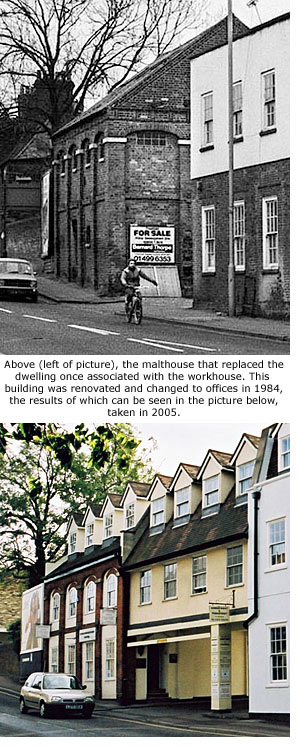 But not all inmates were happy with the new Poor Laws, and individual protests occurred in many workhouses. Whether or not this was the case at Bishop's Stortford, where on Christmas night 1835 an attempt was made to burn down the workhouse mill, it is hard to say. Fortunately the fire was discovered early and extinguished with the aid of 30 or 40 buckets of water. The following morning suspicious inmates were hauled before the Guardians, and three brought before magistrates. After a long investigation three ringleaders were committed to Hertford Gaol, and in March 1836 Thomas Smith, aged 18, and 17-year-old Moses Miller appeared before the Assizes accused of starting the fire. There was, however, little real evidence to convict them and not guilty verdicts were returned – although the judge did say a very strong suspicion of guilt remained. But not all inmates were happy with the new Poor Laws, and individual protests occurred in many workhouses. Whether or not this was the case at Bishop's Stortford, where on Christmas night 1835 an attempt was made to burn down the workhouse mill, it is hard to say. Fortunately the fire was discovered early and extinguished with the aid of 30 or 40 buckets of water. The following morning suspicious inmates were hauled before the Guardians, and three brought before magistrates. After a long investigation three ringleaders were committed to Hertford Gaol, and in March 1836 Thomas Smith, aged 18, and 17-year-old Moses Miller appeared before the Assizes accused of starting the fire. There was, however, little real evidence to convict them and not guilty verdicts were returned – although the judge did say a very strong suspicion of guilt remained.
With the arrival of many more paupers and able-bodied labourers from other parishes, ill-discipline in the old workhouse continued to be a problem as did a lack of space. This forced a decision to build a bigger workhouse, but when the levelling of the proposed site at Barrow's Down (possibly Barrells Down) proved too costly, an alternative site at Haymeads Lane was selected. The Poor Law Commission then refused to provide a loan for the new workhouse, forcing the disgruntled Guardians to borrow in excess of £9,000 from Royal Exchange Assurance – to be repaid over 20 years. A further £1,000 was raised from the auction sale of the workhouse site at Hockerill. The Pest House at Maze Green Road was also sold, and £185. 2s came from the Guardians who purchased the entire contents of the old workhouse to furnish the new. Other contributions came from the sale of workhouses in some other parishes of the Union.
The old workhouse was bought for use as a malting (thought to be by HA & D Taylor) but, apart from necessary changes made to accommodate the malting process, the general layout of the complex remained the same. There is a suggestion that the town's jail was sited here in the mid-to late-1800s, and that possibility remains. The workhouse would have had a ready-made secure area to hold violent inmates, and the town's first police station at Church Street (complete with cells) wasn't built until 1890.
The biggest change to occur was in 1843 when a large part of Hockerill's hillside was cut away for the extension of the railway to Newport. In effect this took away land to the east of the malting, previously owned and used by the workhouse as a garden and possibly a ropewalk. The large dwelling house in Hockerill Street also disappeared at this time, together with the former workhouse bakery, washhouse and workshops that backed onto it. All were replaced by a new malthouse.
Today a part of the malthouse still stands as No 18 Hockerill Street. It survived after the malting ceased to exist circa 1912, and remained intact when the site was bought by United Match Industries, who built their factory here in 1929. It was at that time that any remaining workhouse buildings were finally demolished. The match factory itself was pulled down in the early 1970s, but again the malthouse survived and was included in a 1984 scheme to renovate and refurbish buildings on the south side of Hockerill Street.
Attic rooms and an extension to the rear of the building (now Wilton Court) were added, and the brick arcading (typical of a 19th century malthouse) was inset with new and larger windows. The property is currently occupied by Reynolds Johns Partnership, Solicitors. The adjacent building (No 16), which partly spans the entrance to a small car park, was constructed in 1984. The car park itself was once a part of the workhouse boys' exercise yard. This in turn leads to a large private housing development named Red Lion Court. Also built in the mid 1980s it stands, in its entirety, on the former site of Bishop's Stortford's first Union Workhouse, latterly the Match factory.
No 14a Hockerill Street (Kenyon House) covers the site of the original workhouse entrance, the women's exercise yard, and that of the building used by the trustees of the charities. The only building remaining on the south side of the road from the time of the workhouse is No 14; a late-18th or early-19th century building with mansard roof that formerly stood beside the property occupied by the trustees of the charities.
*The above notes about the geography of the workhouse site are by the website editor. Additional documentary research has been contributed by Jacqueline Cooper from her work on primary sources for the book ‘Bishop’s Stortford – A History’*.
*Available at £16.99 from Boardmans or Ottakar's in the town or by post from the author: jacqueline.cooper@virgin.net
|
|
Hockerill Street
In the early-1960s a proposed road-widening scheme for Hockerill Street threatened this entire area with redevelopment. The plan was partly implemented in Causeway, but the full proposal was not realised and by the late 1970s and mid-80s many of the buildings, neglected by landlords because of the proposed plan, were now in a poor state of repair. By this time, though, local planning favoured renovation rather than demolition (albeit with some exceptions) and many old buildings here have since been saved.
Beyond the (easily missed) railway bridge a wide entrance between renovated buildings leads to residential Baker's Court – needless to say the site of a former bakery – and on the opposite side of the road an overly large sign announces No 21 Hockerill Street. This timber-clad building originally formed part of an extensive malting that was divided in two when the railway cutting was constructed to extend the line to Newport in 1843.
From the mid 1950s it was home to electrical equipment supplier Stort Wholesalers Ltd, who in 2005 took the decision to sell up and move their business to Twyford Business Centre. This they did in 2006, after which the old property was renovated and refurbished for new owners.
Also here from 1903 until 2006 was Bishop's Stortford Bowls Club, of which two past members, G. Watts and J. Elliot, played a leading role in forming the East Herts Bowling Association in 1950. In more recent years the club's finances and the deteriorating fabric of the club prompted its sale for property development, and the move to a new site at Beldams Lane is scheduled for early 2008. Though still within Bishop's Stortford's boundary the newly built club will actually be in Essex!
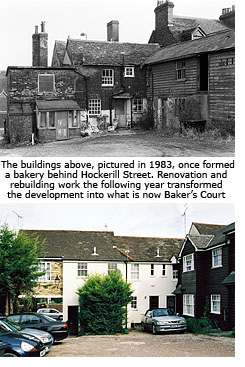 The large property that is No 23 Hockerill Street is thought to have been built around 1500 as a farmhouse. What is now the rear of the building was then the front, facing open fields and the Meads, but when the malting was developed the farmland disappeared and the property became an alehouse called the Chestnut Tree. Reverting back to residential use in Victorian times it later became a shop. As recently as 1999 the property had lapsed into a very poor state of repair but has since been expertly renovated and restored. The large property that is No 23 Hockerill Street is thought to have been built around 1500 as a farmhouse. What is now the rear of the building was then the front, facing open fields and the Meads, but when the malting was developed the farmland disappeared and the property became an alehouse called the Chestnut Tree. Reverting back to residential use in Victorian times it later became a shop. As recently as 1999 the property had lapsed into a very poor state of repair but has since been expertly renovated and restored.
The next entrance on the left leads to a private residential development, built on the site of a 19th century malting. When the malting ceased production in the early 1900s, local resident Ted Barrett (son of Alfred Slapps Barrett) utilised the buildings to create mixed residential, commercial and industrial units. But by the mid 1900s the buildings were once again vacant and in a sorry state of disrepair. Redevelopment of the site in the mid 1980s included new housing but much of the former malting was restored and made habitable, its trademark kiln chimney left intact as a permanent reminder of the area's history.
An excellent example of Late Georgian architecture is No 29 Hockerill Street, once a privately owned house but now used as offices. Alongside it stands the more recently built Fuller House, the product of a liaison between the Royal British Legion Housing Association and the local council, and built as sheltered accommodation for both Legion members and council tenants. Work began on this complex of 62 apartments in 1981 after the previous owner of the site, Franklins Garage, moved to a much larger site at the corner of Causeway and Adderley Road. Fuller House was completed within three years and opened on 24 June 1984.
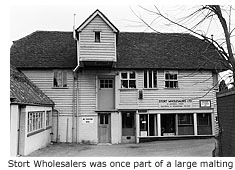 The Legion’s emblem is displayed above a third floor window and the building takes its name from Jim Fuller (1910–1995), one time manager at Hughes timber yard in the Causeway and Hon Treasurer and President of Bishop’s Stortford’s Royal British Legion branch until his death. Misappropriation of the Royal British Legion’s general housing funds unfortunately led to bankruptcy in 1992, and as a result of this the local Legion’s share of this accommodation was taken over by a private concern. The Legion’s emblem is displayed above a third floor window and the building takes its name from Jim Fuller (1910–1995), one time manager at Hughes timber yard in the Causeway and Hon Treasurer and President of Bishop’s Stortford’s Royal British Legion branch until his death. Misappropriation of the Royal British Legion’s general housing funds unfortunately led to bankruptcy in 1992, and as a result of this the local Legion’s share of this accommodation was taken over by a private concern.
Numbers 37 and 38 Hockerill Street were formerly part of the 17th century Red Lion Inn that still stands at the corner of Stansted Road. The two large timber posts supporting the jetty over the pathway are original, but in February 1943 were in danger of disappearing when the Chamber of Trade complained about the frequent damage caused to them by vehicles. The council Surveyor said the only remedy was to either remove the overhanging part of the building or alter the line of the kerb, although this would narrow the road and create an awkward kerb angle. The matter was then refferred to County Council, with a suggestion that the overhanging building be taken down. Fortunately, the council were not prepared to negotiate removal of the overhang and in April that same year instructions were given to paint the posts white and attach reflective discs to them.
On the opposite side of the road is Crown Terrace, built in the early 1900s on land that was previously part of the Crown Inn’s garden. Nearer the crossroads, No 50 Hockerill Street was built around the same time. This property is now a shop with accommodation above, but during World War II was used as a half-way house for expectant mothers prior to admittance to Twyford House maternity hospital (See Thorley – Twyford House). Most of these women were Londoners, sent to the relative safety of Stortford away from the bombing. MORE PICTURES
|


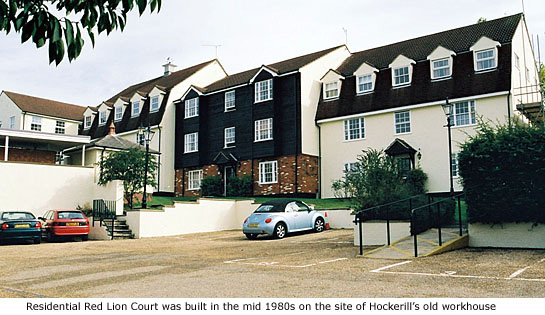
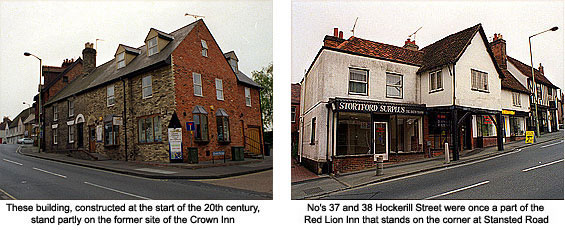

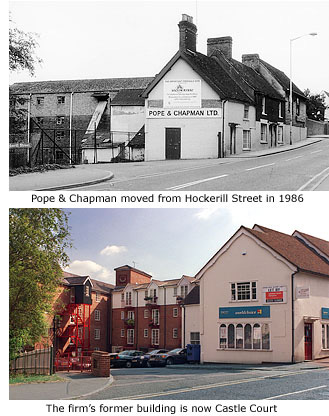 Overlooking Sworder's Field at the bottom of Hockerill Street stands a large apartment block named Castle View, a conversion of the original 19th century building first constructed as a malting and last occupied by seed merchants Pope & Chapman. Their original business, Catling & Co, was established in 1837 at Mark Lane, London, but one of the partners, a Cornishman named George Frederick Chapman (1869–1968), had little love for city life and in 1915 his desire to return to the country brought him to Bishop's Stortford to view these premises.
Overlooking Sworder's Field at the bottom of Hockerill Street stands a large apartment block named Castle View, a conversion of the original 19th century building first constructed as a malting and last occupied by seed merchants Pope & Chapman. Their original business, Catling & Co, was established in 1837 at Mark Lane, London, but one of the partners, a Cornishman named George Frederick Chapman (1869–1968), had little love for city life and in 1915 his desire to return to the country brought him to Bishop's Stortford to view these premises.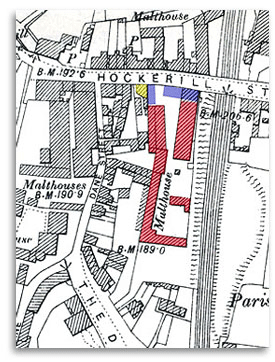
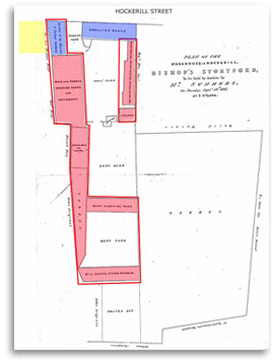

 But not all inmates were happy with the new Poor Laws, and individual protests occurred in many workhouses. Whether or not this was the case at Bishop's Stortford, where on Christmas night 1835 an attempt was made to burn down the workhouse mill, it is hard to say. Fortunately the fire was discovered early and extinguished with the aid of 30 or 40 buckets of water. The following morning suspicious inmates were hauled before the Guardians, and three brought before magistrates. After a long investigation three ringleaders were committed to Hertford Gaol, and in March 1836 Thomas Smith, aged 18, and 17-year-old Moses Miller appeared before the Assizes accused of starting the fire. There was, however, little real evidence to convict them and not guilty verdicts were returned – although the judge did say a very strong suspicion of guilt remained.
But not all inmates were happy with the new Poor Laws, and individual protests occurred in many workhouses. Whether or not this was the case at Bishop's Stortford, where on Christmas night 1835 an attempt was made to burn down the workhouse mill, it is hard to say. Fortunately the fire was discovered early and extinguished with the aid of 30 or 40 buckets of water. The following morning suspicious inmates were hauled before the Guardians, and three brought before magistrates. After a long investigation three ringleaders were committed to Hertford Gaol, and in March 1836 Thomas Smith, aged 18, and 17-year-old Moses Miller appeared before the Assizes accused of starting the fire. There was, however, little real evidence to convict them and not guilty verdicts were returned – although the judge did say a very strong suspicion of guilt remained. The large property that is No 23 Hockerill Street is thought to have been built around 1500 as a farmhouse. What is now the rear of the building was then the front, facing open fields and the Meads, but when the malting was developed the farmland disappeared and the property became an alehouse called the Chestnut Tree. Reverting back to residential use in Victorian times it later became a shop. As recently as 1999 the property had lapsed into a very poor state of repair but has since been expertly renovated and restored.
The large property that is No 23 Hockerill Street is thought to have been built around 1500 as a farmhouse. What is now the rear of the building was then the front, facing open fields and the Meads, but when the malting was developed the farmland disappeared and the property became an alehouse called the Chestnut Tree. Reverting back to residential use in Victorian times it later became a shop. As recently as 1999 the property had lapsed into a very poor state of repair but has since been expertly renovated and restored. The Legion’s emblem is displayed above a third floor window and the building takes its name from Jim Fuller (1910–1995), one time manager at Hughes timber yard in the Causeway and Hon Treasurer and President of Bishop’s Stortford’s Royal British Legion branch until his death. Misappropriation of the Royal British Legion’s general housing funds unfortunately led to bankruptcy in 1992, and as a result of this the local Legion’s share of this accommodation was taken over by a private concern.
The Legion’s emblem is displayed above a third floor window and the building takes its name from Jim Fuller (1910–1995), one time manager at Hughes timber yard in the Causeway and Hon Treasurer and President of Bishop’s Stortford’s Royal British Legion branch until his death. Misappropriation of the Royal British Legion’s general housing funds unfortunately led to bankruptcy in 1992, and as a result of this the local Legion’s share of this accommodation was taken over by a private concern.